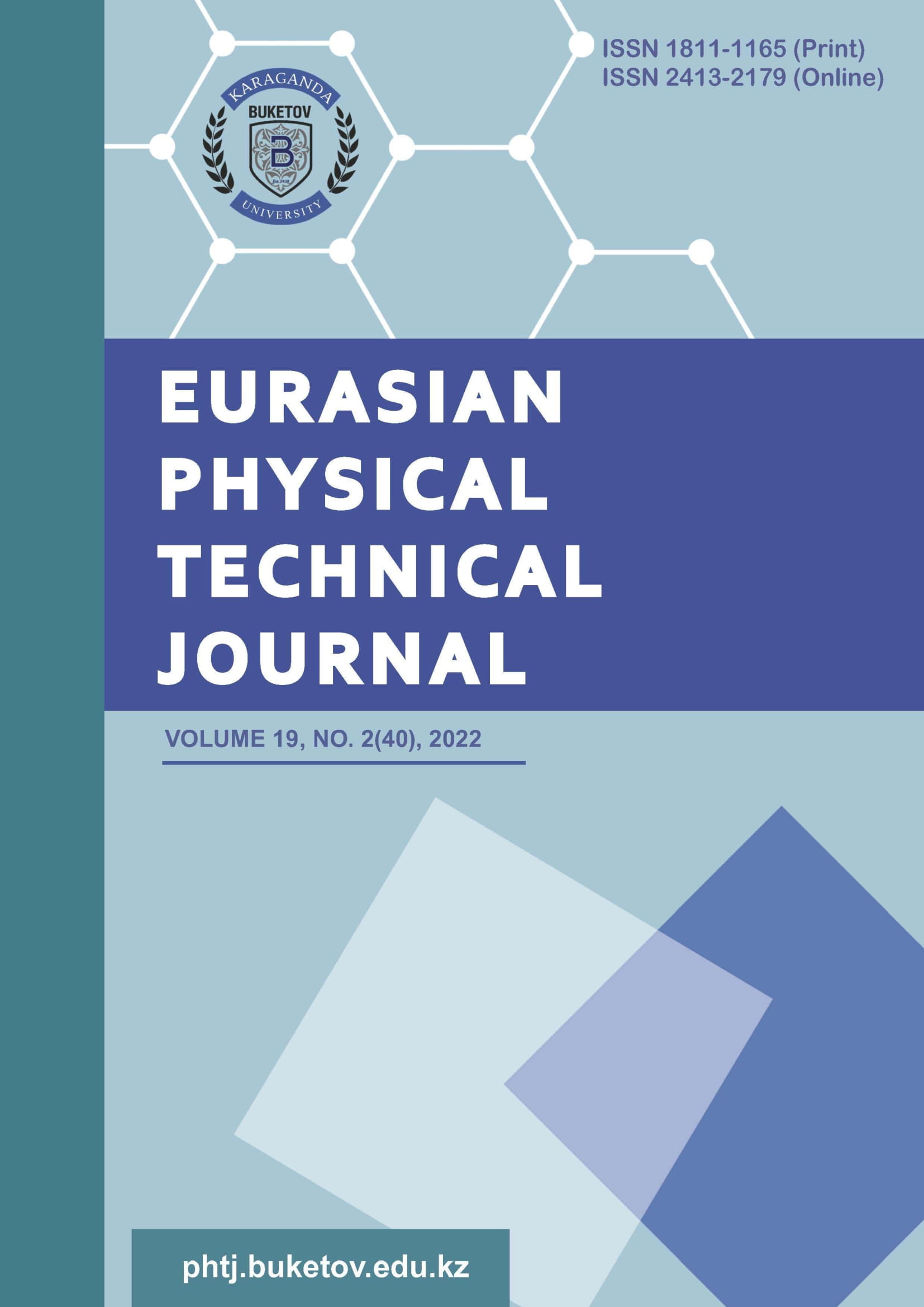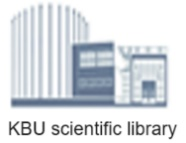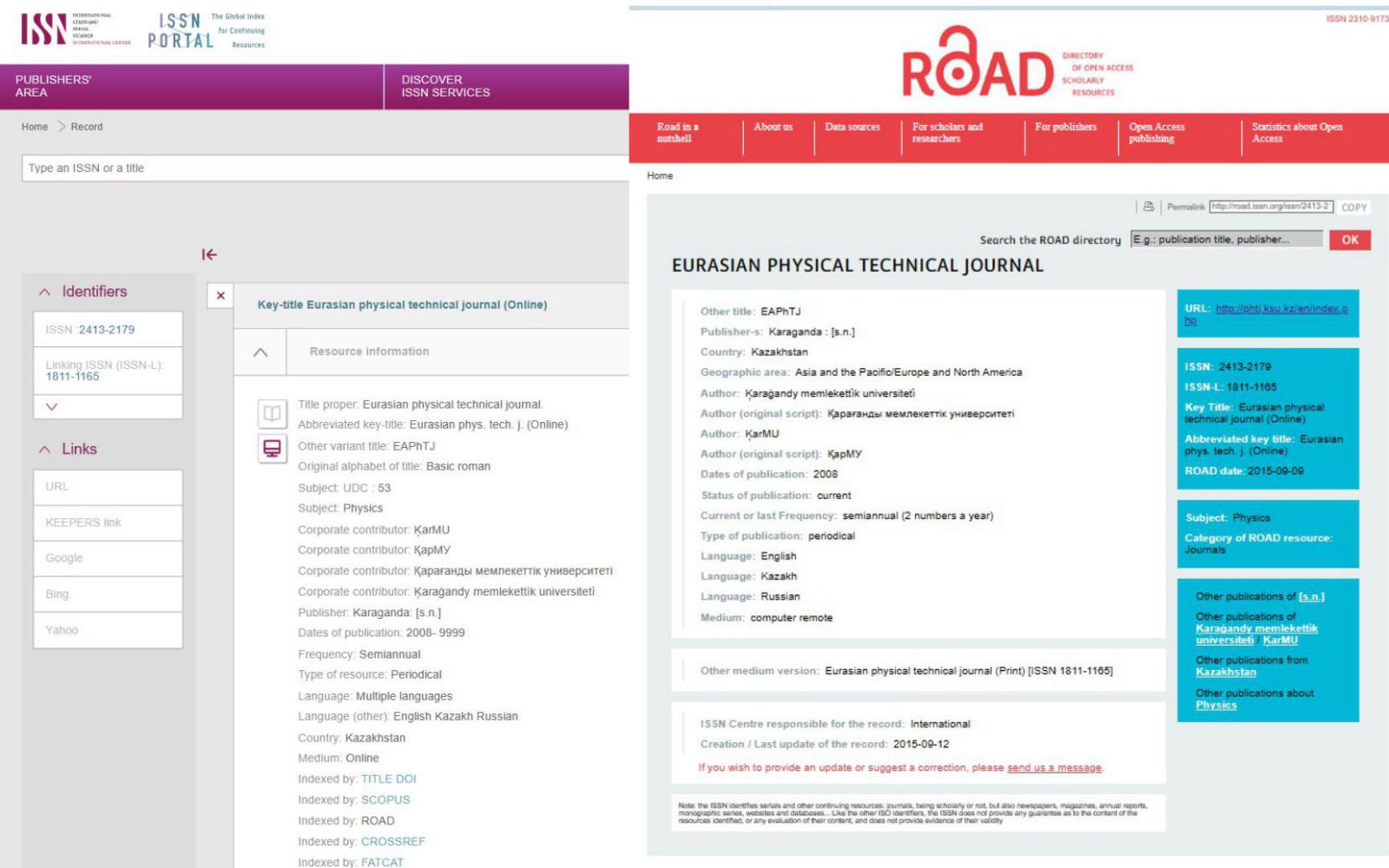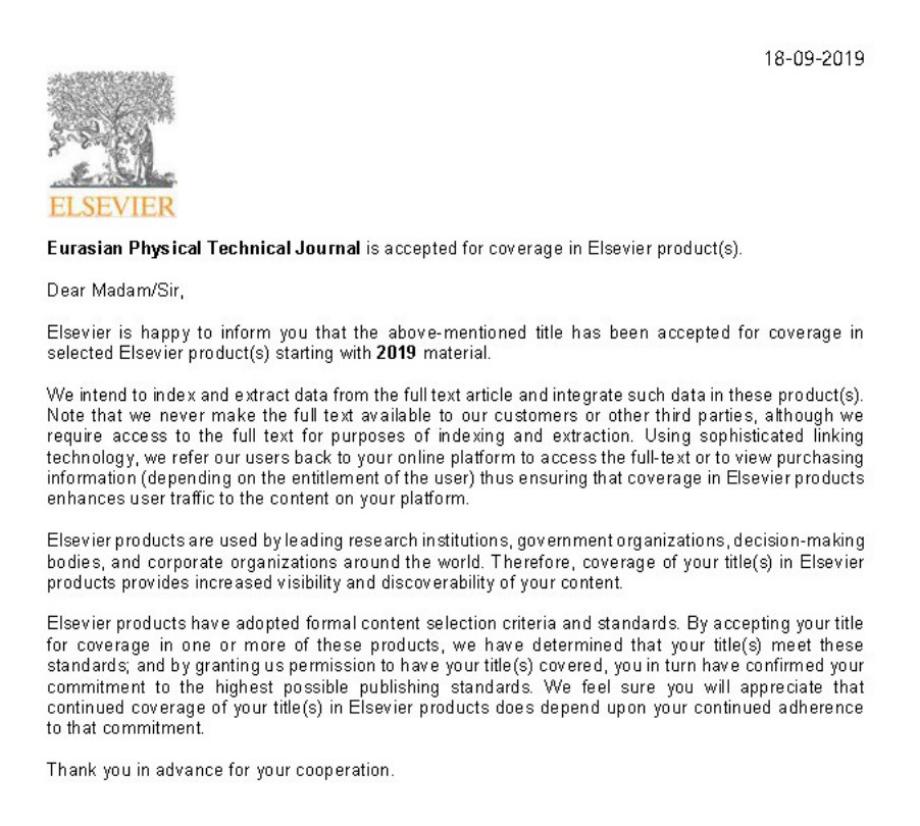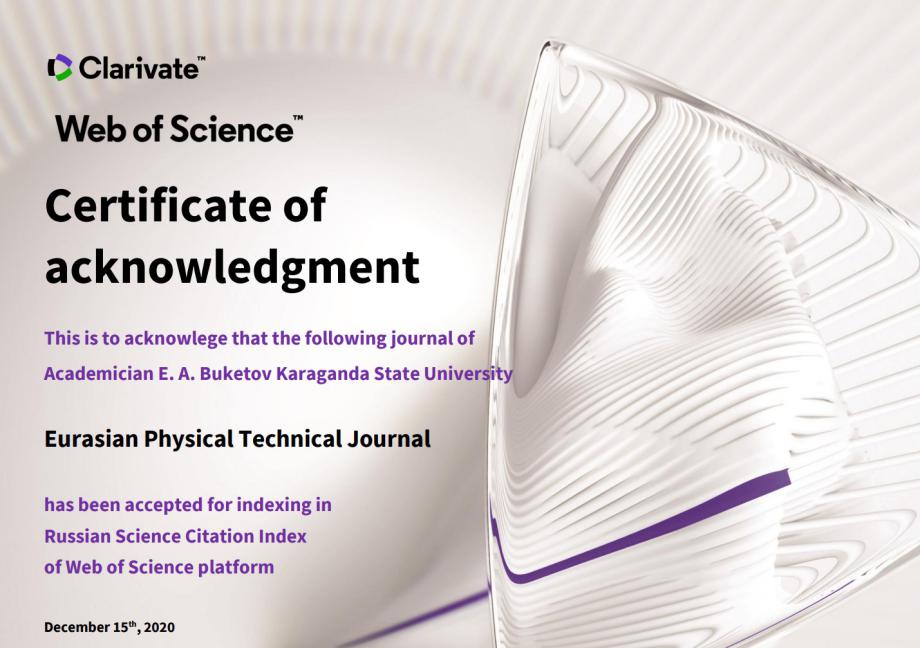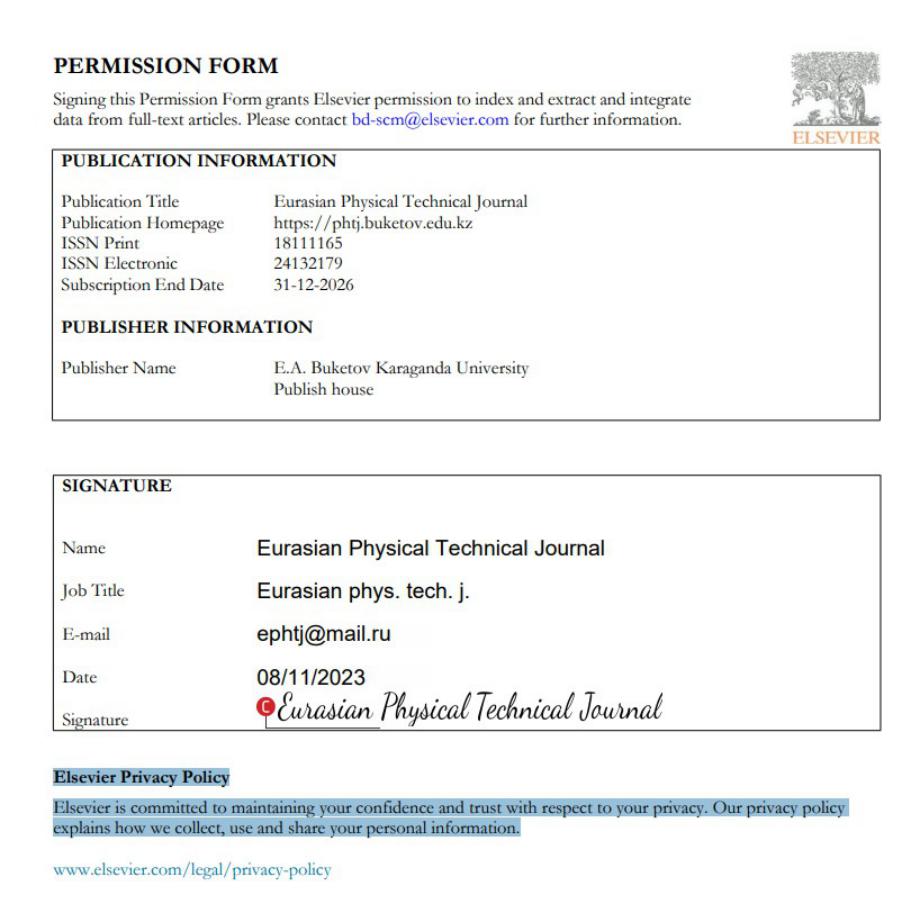PERFORMANCE SIMULATION OF ECO-FRIENDLY SOLAR CELLS BASED ON CH3NH3SnI3
DOI:
https://doi.org/10.31489/2022No2/58-64Keywords:
lead-free, electron-transport layer, hole-transport layer, absorption layer, SCAPS-1DAbstract
Large-scale deployment of the perovskite photovoltaic technology using such high-performance materials as СH3NH3PbI3 may face serious environmental issues in the future. Implementation of perovskite solar cell based on Sn could be an alternative solution for commercialisation. This paper presents the results of a theoretical study of a lead-free, environmentally-friendly photovoltaic cell using СH3NH3SnI3 as a light-absorbing layer. The characteristics of a photovoltaic cell based on perovskite were modelled using the SCAPS-1D program. Various thicknesses of the absorbing layer were analysed, and an optimised device structure is proposed, demonstrating a high power conversion efficiency of up to 28% at ambient temperature. The analysis of the thicknesses of the СH3NH3SnI3 absorbing layer revealed that at a thickness of 500 nm, performance is demonstrated with an efficiency of 27.41 %, a fill factor of 85.92 %, a short circuit current density of 32.60 mA/cm2 and an open-circuit voltage of 0.98 V. The obtained numerical results indicate that the СH3NH3SnI3 absorbing layer may be a viable replacement for the standard materials and may form the basis of a highly efficient technology of the environmentally-friendly perovskite solar cells.
References
Klöckner K., Letmathe P. Is the coherence of coal phase-out and electrolytic hydrogen production the golden path to effective decarbonisation? Applied Energy, 2020, Vol. 279, pp. 115779. doi: 10.1016/j.apenergy.2020.115779.
Carneiro A.L. et al. Energy consumption and carbon footprint of perovskite solar cells. Energy Reports, 2022, Vol. 8, pp. 475–481. doi: 10.1016/j.egyr.2022.01.045.
Gür T.M. Carbon Dioxide Emissions, Capture, Storage and Utilization: Review of Materials, Processes and Technologies. Progress in Energy and Combustion Science, 2022, Vol. 89, pp. 100965.
Martinho F. Challenges for the future of tandem photovoltaics on the path to terawatt levels: a technology review. Energy & Environmental Science, 2021, Vol. 14, No. 7, pp. 3840–3871. doi: 10.1039/D1EE00540E.
Cousse J. Still in love with solar energy? Installation size, affect, and the social acceptance of renewable energy technologies. Renewable and Sustainable Energy Reviews, 2021, Vol. 145, pp. 111107.
Jena A.K., Kulkarni A., Miyasaka T. Halide Perovskite Photovoltaics: Background, Status, and Future Prospects. Chemical Reviews, 2019, Vol. 119, No. 5, pp. 3036–3103. doi: 10.1021/acs.chemrev.8b00539.
Reddy S.H., Di Giacomo F., Di Carlo A. Low‐Temperature‐Processed Stable Perovskite Solar Cells and Modules: A Comprehensive Review. Advanced Energy Materials, 2022, Vol. 12, No. 13, pp. 2103534.
Chapin D.M., Fuller C.S., Pearson G.L. A New Silicon p‐n Junction Photocell for Converting Solar Radiation into Electrical Power. Journal of Applied Physics, 1954, Vol. 25, No. 5, pp. 676–677. doi: 10.1063/1.1721711.
Green M.A. et al. Solar cell efficiency tables (Version 53). Progress in Photovoltaics: Research and Applications, 2019, Vol. 27, No. 1, pp. 3–12. doi: 10.1002/pip.3102.
Zu F. et al. Illumination‐Driven Energy Level Realignment at Buried Interfaces between Organic Charge Transport Layers and a Lead Halide Perovskite. Solar RRL, 2022, pp. 2101065. doi: 10.1002/solr.202101065.
Jeong M. et al. Stable perovskite solar cells with efficiency exceeding 24.8% and 0.3-V voltage loss. Science, 2020, Vol. 369, No. 6511, pp. 1615–1620. doi: 10.1126/science.abb7167.
Min H. et al. Perovskite solar cells with atomically coherent interlayers on SnO2 electrodes. Nature, 2021, Vol. 598, No. 7881, pp. 444–450. doi: 10.1038/s41586-021-03964-8.
Park S.Y., Zhu K. Advances in SnO 2 for Efficient and Stable n–i–p Perovskite Solar Cells. Advanced Materials, 2022, pp. 2110438. doi: 10.1002/adma.202110438.
Herterich J. et al. Ion Movement Explains Huge V OC Increase despite Almost Unchanged Internal Quasi‐Fermi‐Level Splitting in Planar Perovskite Solar Cells. Energy Technology, 2021, Vol. 9, No. 5, pp. 2001104.
Morana M., Malavasi L. Pressure Effects on Lead‐Free Metal Halide Perovskites: a Route to Design Optimized Materials for Photovoltaics. Solar RRL, 2021, Vol. 5, No. 11, pp. 2100550. doi: 10.1002/solr.202100550.
Ghimire S. et al. Structural Reconstruction in Lead-Free Two-Dimensional Tin Iodide Perovskites Leading to High Quantum Yield Emission. ACS Energy Letters, 2022, Vol. 7, No. 3, pp. 975–983.
Wuttig M. et al. Halide Perovskites: Advanced Photovoltaic Materials Empowered by a Unique Bonding Mechanism. Advanced Functional Materials, 2022, Vol. 32, No. 2, pp. 2110166. doi: 10.1002/adfm.202110166.
Meier F. et al. Charge Carrier Dynamics of Multiple-Cation Mixed-Halide Perovskite Thin Films. The Journal of Physical Chemistry C, 2021, Vol. 125, No. 31, pp. 17411–17417. doi: 10.1021/acs.jpcc.1c04302.
Deepthi Jayan K., Sebastian V. Comprehensive device modelling and performance analysis of MASnI3 based perovskite solar cells with diverse ETM, HTM and back metal contacts. Solar Energy, 2021, Vol. 217, pp. 40–48.
Patel P.K. Device simulation of highly efficient eco-friendly CH3NH3SnI3 perovskite solar cell. Scientific Reports, 2021, Vol. 11, No. 1, pp. 3082. doi: 10.1038/s41598-021-82817-w.
Singh A.K. et al. Performance optimization of lead free-MASnI3 based solar cell with 27% efficiency by numerical simulation. Optical Materials, 2021, Vol. 117, pp. 111193. doi: 10.1016/j.optmat.2021.111193.
Kanoun A.-A. et al. Toward development of high-performance perovskite solar cells based on CH3NH3GeI3 using computational approach. Solar Energy, 2019, Vol. 182, pp. 237–244. doi: 10.1016/j.solener.2019.02.041.
Tariq Jan S., Noman M. Influence of layer thickness, defect density, doping concentration, interface defects, work function, working temperature and reflecting coating on lead-free perovskite solar cell. Solar Energy, 2022, Vol. 237, pp. 29–43. doi: 10.1016/j.solener.2022.03.069.
Zeinidenov A. et al. The effect of MoO3 interlayer on electro-physical characteristics of the perovskite solar cells. Synthetic Metals, 2021, Vol. 281, pp. 116903. doi: 10.1016/j.synthmet.2021.116903.
Aimukhanov А.К. et al. Influence of surface structure and morphology of PEDOT: PSS on its optical and electrophysical characteristics. Bulletin of the Karaganda University. Physics series.2021, Vol. 103, No. 3, pp. 93–100.
Rombach F.M., Haque S.A., Macdonald T.J. Lessons learned from spiro-OMeTAD and PTAA in perovskite solar cells. Energy & Environmental Science, 2021, Vol. 14, No. 10, pp. 5161–5190. doi: 10.1039/D1EE02095A.
Aimukhanov A.K. et al. The influence of structural and charge transport properties of PEDOT : PSS layers on the photovoltaic properties of polymer solar cells. Polymers for Advanced Technologies, 2021, Vol. 32, No. 2, pp. 497–504. doi: 10.1002/pat.5102.
Salem M.S. et al. Analysis of Hybrid Hetero-Homo Junction Lead-Free Perovskite Solar Cells by SCAPS Simulator. Energies, 2021, Vol. 14, No. 18, pp. 5741. doi: 10.3390/en14185741.
Abdelaziz S. et al. Investigation of lead-free MASnI3-MASnIBr2 tandem solar cell: Numerical simulation. Optical Materials, 2022, Vol. 123, pp. 111893. doi: 10.1016/j.optmat.2021.111893.
Deepthi Jayan K., Sebastian V. Comprehensive device modelling and performance analysis of MASnI3 based perovskite solar cells with diverse ETM, HTM and back metal contacts. Solar Energy, 2021, Vol. 217, pp. 40–48.
Kumar M. et al. An optimized lead-free formamidinium Sn-based perovskite solar cell design for high power conversion efficiency by SCAPS simulation. Optical Materials, 2020, Vol. 108, pp. 110213.

